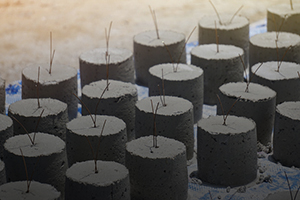Living Concrete

A new type of concrete that is grown from bacteria could be the next step toward self-replicating building materials. Unlike previous research into self-healing bricks, which centered on adding bacteria to traditional concrete, the new material actually uses the bacteria to generate the minerals that give the concrete its strength. In addition, the bacteria can be kept alive to continue the process later on.
Cyanobacteria were placed in a mixture of warm water, sand and nutrients, and placed in a mold. When exposed to light, the bacteria produced calcium carbonate, which cemented the sand particles together. To speed up the process, gelatin was added, which provided additional structure and enhanced the bacterial activity. It took about one day to form bright green blocks about the size of a shoebox.
At room temperature and humidity, the bacteria eventually died out, but when exposed again to higher temperatures and moisture, they can regenerate even after a few weeks. When cut in half and placed back in a mold with more sand, water and nutrients, they will form a new block. The process can be repeated up to three times to yield eight blocks from a single original.
The new concrete is ideally suited for use in areas where trucking in large amounts of building materials is impractical. And because it’s not dependent on virgin sand (which is the case with most concrete), it provides a way to put waste materials like ground glass or even recycled concrete to use.
For information: Wil Srubar, University of Colorado, Civil, Environmental and Architectural Engineering, 1111 Engineering Drive Boulder, CO 80309; phone: 303-492-2621; email: wsrubar@colorado.edu; website: https://www.colorado.edu/ or https://spot.colorado.edu/~wisr7047/